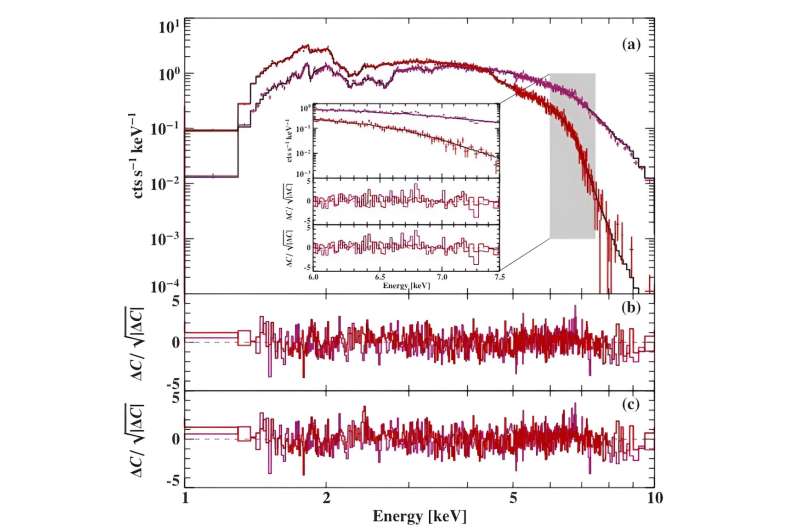June 25, 2024 report
This article has been reviewed according to Science X's editorial process and policies. Editors have highlighted the following attributes while ensuring the content's credibility:
fact-checked
preprint
trusted source
proofread
Astronomers study evolution of a giant outburst in X-ray binary EXO 2030+375

An international team of astronomers has observed an X-ray binary system known as EXO 2030+375. Results of the observation campaign, presented in a research paper published June 18 on the pre-print server arXiv, provide more insights into the evolution and nature of a giant outburst of this system observed three years ago.
X-ray binaries (XRBs) consist of a normal star or a white dwarf transferring mass onto a compact neutron star or a black hole. Based on the mass of the companion star, astronomers divide them into low-mass X-ray binaries (LMXB) and high-mass X-ray binaries (HMXB).
Be/X-ray binaries (BeXRBs) are the largest subgroup of HMXBs. These systems consist of Be stars and, usually, neutron stars, including pulsars. Observations have found that most of these systems showcase weak persistent X-ray emission that is interrupted by outbursts lasting several weeks.
EXO 2030+375 is a BeXRB discovered in 1985 during a strong X-ray outburst. The system is composed of a magnetized neutron star and a B0 Ve companion. The orbital period of EXO 2030+375 is 46 days and the neutron star exhibits X-ray pulsations with a period of approximately 43 seconds. The binary is most likely 7,800 light years away, however some studies point to a closer distance.
Three giant outbursts have been observed from EXO 2030+375 so far—in 1985, 2006, and 2021. The latest outburst, which started in July 2021, has been observed with the Nuclear Spectroscopic Telescope Array (NuSTAR) spacecraft and with the Neutron Star Interior Composition Explorer (NICER) onboard the International Space Station (ISS). The observations were conducted by a group of astronomers led by Ralf Ballhausen of the University of Maryland College Park.
The observations EXO 2030+375 detected a drastic spectral transition characterized by a spectral hardening toward lower luminosity. This finding is surprising as many accreting pulsars show stable, power-law like continuum mostly formed by Comptonized bremsstrahlung at luminosities above 10 undecillion erg/s. The astronomers noted that significant spectral transitions toward low-luminosity accretion are expected at lower luminosities.
According to the study, the reported spectral hardening cannot be described by a simple change in the power-law index or folding energy, but requires additional absorption or emission components. It turned out that NuSTAR observations confirmed the presence of such an absorption feature at 10 keV, which was suggested by previous studies. The researchers suppose that this feature is a product of the complex continuum formation.
By analyzing the collected data, the authors of the study detected no strong absorption or emission lines. However, NICER monitoring identified a moderate variability of the iron line equivalent width.
More information: R. Ballhausen et al, The giant outburst of EXO 2030+375 II: Broadband spectroscopy and evolution, arXiv (2024). DOI: 10.48550/arxiv.2406.13029
Journal information: arXiv
© 2024 Science X Network




















